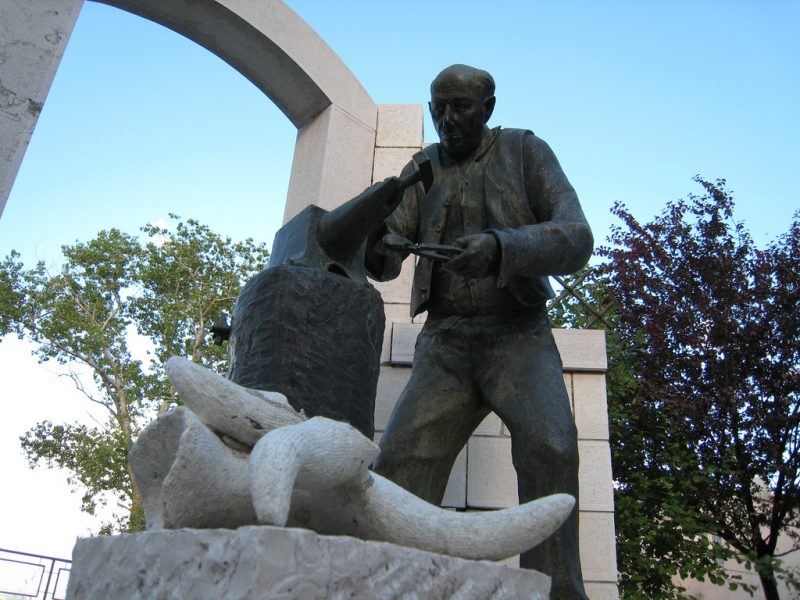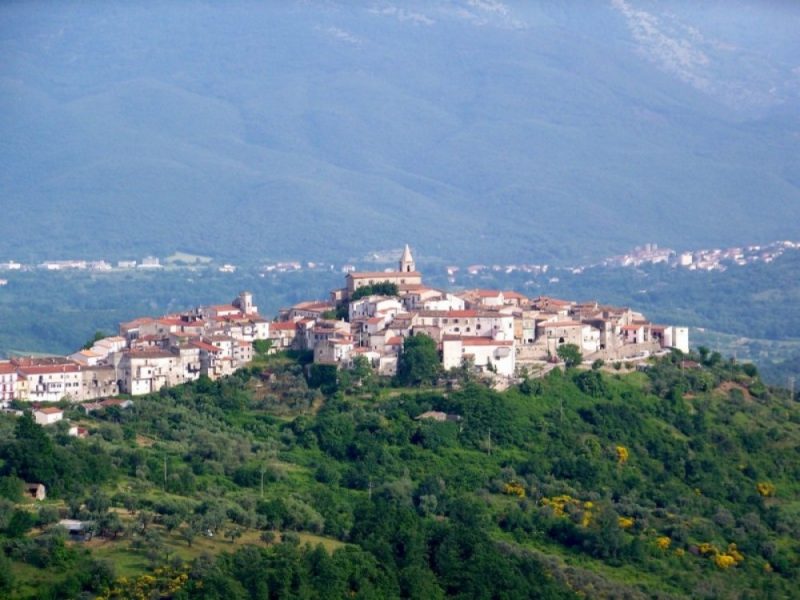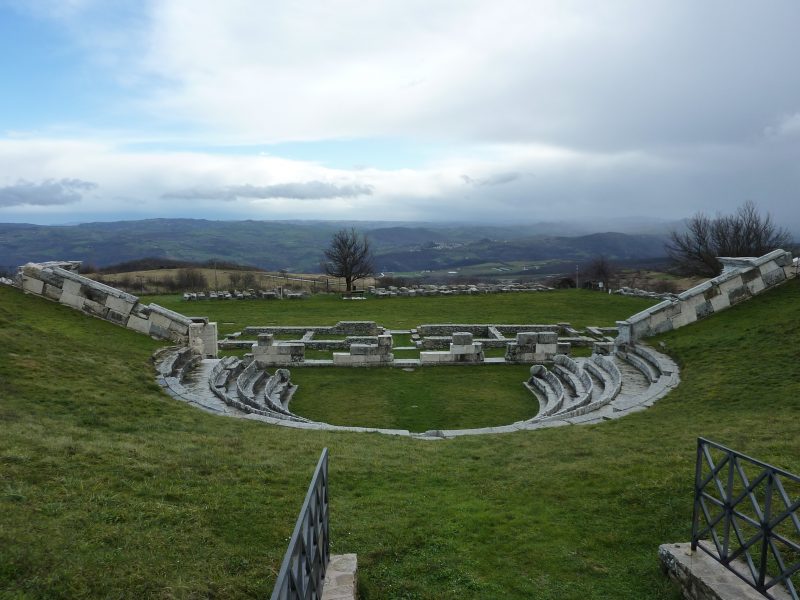The Borgo of Isernia
Isernia overlooks a pristine landscape of hills and small villages, with lush shades of green rolling down the slopes to embrace the houses of the periphery.
The borgo is an ancient network of charming lanes connecting churches and modest houses. It is a proud and determined city: over the centuries many have tried to destroy it, but its steadfast citizens have been stronger, unshakable in their desire for survival and rebirth. In 1943, American bombs razed an entire area of the city to the ground, but the population refused to let them have the final say, and today, Piazza Celestino V stands proudly where the bombs hit, with its elaborate pavement-work in memory of the lives that were lost and the homes that were destroyed. Fontana Fraterna faces this public square, and like the water flowing from its source, Isernia never stops, balancing between the archaic Roman temple of Jupiter , and the elegant influence of the Cathedral, between authentic flavors and timeless traditions. This delicate balance recounts Isernia’s indomitable spirit, always growing toward the future, while never forgetting the past.
History
In 1978, the discovery of a prehistoric site marked the presence of human beings in Isernia dating back to distant antiquity. This city is certainly the most ancient in Molise, and perhaps all of Italy, as demonstrated by the ancient settlements in the Pineta area, and the discovery of the presence of Homo Aeserniensis, who lived 700,000 years ago, and is considered the direct ancestor of Homo Erectus.
The official foundation of Isernia dates back to the eighth century BC, when the south of Italy was inhabited by the Samnite population, who during an ancient ritual called Ver Sacrum had sent their young men to colonize new territories. Isernia was founded in a strategic position, in a point of fundamental importance for communication between the Samnite tribes.
It was not long before the Romans sensed the potential of this town, and in 263 BC, they hastened to conquer it and establish a colony with monetary rights, triggering what is now known as the Civil Wars, a series of clashes between the Samnite League and Rome. Once conquered, Isernia remained loyal to Rome over the centuries, even during the Punic Wars when it was barbarously sacked by Hannibal.
With the fall of the Roman Empire, Isernia suffered the same fate as the rest of the Italian peninsula, and in 456 AD the city was destroyed by Genserico, the King of the Vandals.
During the Lombard domination in the seventh and eighth century AD, Isernia was raised to the rank of county, and also benefited from the construction of a new urban plan as well as a castle and religious buildings, especially convents. It was not long before the city became a vibrant cultural center, partially thanks to the influence of the Benedictine monks, who in return, received land and privileges.
The Middle Ages were not just a period of rebirth for the city, it was also repeatedly looted and set afire. Of all the barbarian attacks, the worst occurred under the dominion of the Franks, with three particularly brutal invasions by the Saracen Turks, in one of their invasions slaughtering some 1,000 Benedictine monks.
During the period of Swabian dominion, Isernia was given the status of ‘città regia’, or royal city.
Starting from the thirteenth century, Isernia was annexed by the Kingdom of Naples, and came under the influence of the historical events concerning that kingdom.
There is an unresolved debate regarding Isernia and a famous historical figure of this period. Some maintain that at the beginning of the 1200’s, Isernia was the birthplace of Pietro da Morrone, who later became Pope Celestino V, the first pope in history to abdicate, and also the founder of the Celestine order. The question is still open, and the roots of this pope continue to be disputed between the cities of Isernia and Sant’Angelo Limosano.
Isernia lost it royal status with the advent of the Angevin domination, again becoming a fief, and from the 1300’s on, Isernia was governed by a succession of dynasties until 1710, when the feif was acquired by Cesare Michelangelo D’Avolos. In 1743, Isernia regained its status as a royal city, this time ‘in perpetuo’.
At the end of the 1700’s, Isernia was the most populated city in the area and in 1799, fervently opposed the French troops who were preparing to conquer the Kingdom of Naples.
During the next two centuries the city was struck by various natural calamities and both World Wars, but there were two events so terrible that Isernia still grieves over them: the earthquake of Sant’Anna in 1805, which seriously damaged most of the region of Molise, and the bombings of the city by the United States on September 10, 1943.
Despite everything, the period after the Second World War was a time of rebirth for the city, and on March 3, 1970, Isernia had the honor of being proclaimed the capital of the Molise Region.
Fontana Fraterna, the Fraternal Fountain
The Fontana Fraterna is the symbol of Isernia, and is one of the six most beautiful fountains in Italy. It was created using limestone blocks from other monuments, some from Ancient Rome. It is composed of stone slabs supporting six columns with arches. The largest slab, placed in the center, is decorated with dolphins and flowers and probably comes from a tomb. Because of the incision on the side of the slab: ‘Ae Pont’, it was long believed that it had originally belonged to a funeral monument of the Pontia family, perhaps to even Pontius Pilate himself, but this is unfounded.
The fountain is called “Fraterna” because, according to tradition, it was made near the site of the brotherhood founded by Celestino V. Regardless, it is still difficult to know the exact date of its construction, being that it was made from other monuments, and also because it was moved from its original location. A commemorative plaque on one side of the fountain suggests that the fountain was commissioned by the Rampino family, relatives of Maria Rampino, who was the wife of Benedetto d’Isernia, an important chancellor in during the era of Emperor Federico II in the 1200’s. There are other elements suggesting that this monument may date back to the period of Federico II. First of all, the architectural form and structure is typical of the era, and secondly, there are stylistic elements commonly used in Federico’s constructions, such as the reproduction of the number three in the structure, which is divided in three sections, and in the columns, where again, three are round and three are octagonal, the octagon being another of the Emperor’s favorite symbolic elements.
Despite these intriguing clues, we cannot be certain the fountain dates back to the period of Swabian reign, given that it was originally located near the Cathedral, but was then dismantled in the 1800’s and transferred to where it is today, in order to facilitate the passage of a royal procession during the King’s visit to Isernia. In truth, we cannot be sure that the fountain we see today reflects its original form, even though the structural elements all coincide.
Furthermore, the Fontana Fraterna was seriously damaged during the bombings in 1943, and was then dismantled and reconstructed more than once, not always following historical-scientific protocol.
Today, the fountain is still the fulcrum of life in Isernia and the most important symbol of this city.
Cattedrale di San Pietro Apostolo, the Cathedral of St. Peter the Apostle
The Romans chose Isernia as the location to build an imposing temple dedicated to their most important deity: Jupiter, or “Giove”. Later, Christians transformed this pagan place of worship into the location for their cathedral, consecrated to St. Peter the Apostle, the direct successor of Jesus Christ.
Over the course of the centuries, natural calamities and human negligence made it necessary for this sacred building to undergo extensive renovations which have altered its original features. The appearance we see today is largely due to modifications implemented in the 1800’s by the Bishop Paladino, who sought to give the church a neo-classical imprint, as can be seen from the façade, characterized by a tympanum in travertine, supported by side pillars and four central columns.
Signs of other alterations from past eras are still visible, for example the portal in Baroque style, located on the left side of the cathedral.
Changes to the interior also followed the guidelines of Bishop Paladino. Today, the space is subdivided into three naves. On the counter-face of the central nave there is a carved wooden choir box to which the organ pipes are connected. This organ was crafted in the 1890’s, and although it is relatively recent, it is one of the most valuable pieces in the Church, made by the organ builders Fratelli Ruffatti of Padua.
The internal cap of the dome, constructed between 1927 and 1928 was not damaged in the bombing of 1943 or in the earthquake of 1984, and is therefore one of the few elements which has preserved the original fresco decorations, which elaborate the central theme of the Assumption.
The flooring is one of the most recent additions, created in 2002, with large areas of glass panels, to expose the archeological excavations below the church.
Exiting the cathedral, the bell tower is on the left side, rising in the same place as a previous, more ancient tower. The tower is known as the ‘Arch of St. Peter’, because of its arch, through which Corso Marcelli passes. Its current appearance reflects the restorations made in 1456. It is a squat tower with a square base, divided in four parts by cornices, with the city clock at the top.
Tempio di Giove, the Temple of Jupiter
Where the Cathedral of San Pietro Apostolo stands today, there once stood an imposing Roman temple, constructed in the third century AD and probably dedicated to the Capitolene Triad: Jupiter, Juno and Minerva. The ruins of this ancient monument can be viewed in part under the cathedral and in part under the adjacent episcopium. Although the perimeters of these two places of worship are similar, the entrance to the Roman temple was diametrically opposite to that of the cathedral, and opened onto what today is the street of Vico Giobbe.
Inside the temple are two sarcophagi that were used for Christian burial, probably two bishops. The rooms were full of brightly colored frescos, and many of the colors are still visible today. Unfortunately the Temple of Jupiter suffered considerable damage in Isernia’s numerous earthquakes, but archeologists have chosen to leave the collapsed parts exactly where they were, to respect the continuity of the structure.
Museo Nazionale del Paleolitico d’Isernia, The National Paleolithic Museum of Isernia
The National Paleolithic Museum of Isernia is located in La Pineta, an area near the city. In 1978, during the construction of the Napoli-Vasto highway, an important archeological site was discovered, and since then, continual research and excavation activities have been underway in the area.
The archeological site of La Pintea is one of the most important in Italy, because of the vast number of relics and finds, and also because of the discovery of traces of the most ancient primitive humans in Italy, identified as Homo Isearniensis, who existed some 700,000 years ago.
The museum was conceived as a permanent, functioning laboratory for visitors to learn about the archeological activities and discoveries made here in recent years, through a series of specially designed pavilions, where visitors can also participate directly in the work itself. In fact, the most important pavilion in the museum is the one dedicated to the live archeological digs. It is 700 square meters and divided in two levels, the lower level, where archeological excavations are carried out, and the upper level, where visitors can watch an actual archeological dig in process.
This site has the most abundant archeological material in the entire area, and as it is covered and protected from the elements, excavation work can continue in the winter months as well.
Many of the finds discovered here, after being restored, are now on display in the exhibition hall, where explanatory panels recount the history of the site and also the characteristics and functionality of the objects that have been discovered. The final pavilion in the museum is 800 square meters and takes visitors on an educational journey through history, retracing the long path of human evolution from the Paleolithic era to the Metal Ages, with special attention to the Prehistory of Molise. This pavilion also features reconstructions of prehistoric environments, such as a Paleolithic hut as it must have been furnished, and a reproduction of a cave dwelling by Morricone del Pesco, who has recreated an archeological site with line engravings and black cave paintings.
The ‘Museo Nazionale del Paleolitico d’Isernia’ is of enormous historical, scientific and cultural importance, and is recognized by UNESCO, which has awarded the museum with the prestigious blue shield, a guarantee of international protection in case of civil/military conflict or natural calamities.
Sito Archeologico La Pineta, the La Pineta Archeological Site
There are innumerable prehistoric sites in Italy, so why should La Pineta of Isernia be considered one of the most important? The answer is as simple as it is complex. As often happens, the archeological site was discovered by chance during the construction of a highway in 1978. Since then, the site has been in operation, with intense archeological research and interdisciplinary studies continually under way. The vast abundance of relics found in the area is making it possible to reconstruct the environment and the way of life of primitive man (Homo Aeserniensis), who existed 700,000 years ago in this area, which is renowned as the location of the first human settlement in Europe.
Over the years, we have been able to ascertain that environment in which this first hominid lived was characterized by an eco-system much like the African Savannah, populated by an abundance of species: bison, rhinoceros, hippopotamus, bears, elephants, and deer.
The enormous quantity of stone artifacts, such as pieces of lances and cutting blades, crafted from limestone and flint, has led to two conclusions: first, that these hominids were extremely familiar with the territory, and second, it was their custom to butcher animals for meat. It is therefore evident that these primitive humans were highly skilled at making the most of the resources offered by the environment in order to ensure their survival.
Some of the excavations have revealed the presence of humid environments in the territory, probably small lakes formed by water flowing from the nearby mountains. The bones found in this area, and in particular, at the edge of the water sources, suggests that it was customary to drag the carcasses of animals near these small lakes, probably because they were considered safer areas, but also because as the animals were butchered and chopped into meat, the water could be used for cleaning and limiting the smell of putrefaction.
As we have seen, this site is a key link for reconstructing the millennial history of Europe, and to this regard, in 1999 a covered pavilion was inaugurated in an excavation area of 700 square meters, which allows archeologists to continue working during the winter months and also makes it possible for visitors to observe the work in progress.
The Pineta area and the National Paleolithic Museum of Isernia have immense symbolic value for Molise and all of Italy. Over the years it has created employment opportunities for many young researchers and continues to be a source of hope for future generations: in the year 2017 the number of visitors increased exponentially.
The City of Lace
As you stroll through the streets of Isernia on a summer’s day, you can still see an age-old tradition: local women sitting on their doorsteps, with their heads plunged in elegant patterns of handmade lace. As their hands skillfully work the spindles, their chatter floats through the streets as lightly as the air around them.
The use of the traditional lace-making instrument, the “ tombolo” is a delicate art, and in Isernia it is still passed down from grandmothers to their granddaughters, carrying on a tradition with roots going back to the ancient halls of time. In the past, the dowry of the trousseau was of considerable importance for a girl of marriageable age, and even more so for her mother and future mother-in-law. For this important social ritual, nothing was considered more prestigious than adornments made with delicate handmade lace. In Isernia, the women who did not work in the fields dedicated themselves with care and precision to this noble art, which was always in high demand. Today, the “tombolo” is still used with the traditional roller-shaped cushion, called “pallone”, or balloon. The lace pieces created with this ancient technique are truly exquisite works of art, but their presence in Italian homes has become a rarity.
Only a small circle of people practice ‘l’arte del bello’, (the art of beauty), as the ancient technique of lace-making is called. Sadly, very few people are able to recognize the worth of these handmade pieces when they see them, and even fewer are able to afford them!
Nevertheless, lace production still continues in Molise, with Isernia as the capital of production, followed by a procession of towns, small and large, that have chosen to go against the trend of industrial textiles, leading the way toward a revaluation of this artisanal expression of Italian excellence.
Pope Celestino V
Pope Celestino V was born at the beginning of the 1200’s under the name of Pietro del Morrone. Still today, there is dispute regarding his place of birth, which is contested as being either in Isernia or Sant’Angelo Limosano.
A fervent spiritual seeker, he spent most of his life in seclusion as a hermit on a mountain near Sulmona, and in 1264 he founded a brotherhood of hermetic monks, which later, after his internment as pope, took the name of the Confraternity of the Celestines.
Word of his fame as a saintly and devout Christian spread, and following the death of Pope Nicholas IV in 1992, after the papal seat remained vacant for a good two years, the prelates turned their attention to the hermit monk, who also had the favor of King Charles of Anjou.
He was consecrated as Pope in 1294 with the name Celestino V, but his advanced age was not in his favor, and he soon realized that he was powerless before the demands of the cardinals and especially Charles of Anjou. For this reason, he decided to abdicate that same year, in December 1294.
His successor was Bonifacio XVIII, famous for having condemned Dante to exile for speculating on the sale of indulgences. While still a cardinal, Bonifacio XVIII had heavily pressured Celestino V to abdicate, and in the fear that he would change his mind, once Bonifacio came to power, he put the ex-pope under surveillance, eventually imprisoning him in Castello di Fumone, where he died in 1296.
Celestino V was canonized in 1313.
______________________________________
Do you known of any famous people related to this borgo? Contact us!
“La Cipollata” (Onions and Eggs)
You may love them, you may hate them, but any way you slice it, onions are one of the most controversial ingredients in Italian cuisine. Isernia produces a special onion typical to the area, recognized for its white color and slightly crushed bulb, called “la Cipolla di Isernia”. So, the traditional dish of the borgo could not be anything other than “La Cipollata”.
Ingredients:
- 8 medium sized Isernia onions;
- 4 whole eggs;
- extra virgin olive oil;
- salt;
- chopped fresh parsley.
Procedure:
Finely slice the onions and rinse them in running water to decrease the acidity. Heat a few tablespoons of oil and water in a pan and then add the onions and let them stew. After a few minutes, add salt and the chopped parsley and cover with a lid. When the onions are stewed and of a soft consistency, add the whole eggs, breaking them directly into the pan, and cover again. When the egg white covers the yolk, as in typical fried eggs, your dish is ready to serve.
This ancient, traditional dish was a typical breakfast for farmers who needed nourishment and energy for working in the fields.
_________________________________
Do you known other typical recipes related to this borgo? Contact us!

 Italiano
Italiano
 Deutsch
Deutsch











